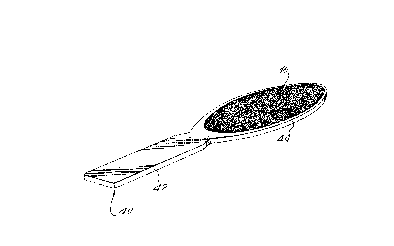Une partie des informations de ce site Web a été fournie par des sources externes. Le gouvernement du Canada n'assume aucune responsabilité concernant la précision, l'actualité ou la fiabilité des informations fournies par les sources externes. Les utilisateurs qui désirent employer cette information devraient consulter directement la source des informations. Le contenu fourni par les sources externes n'est pas assujetti aux exigences sur les langues officielles, la protection des renseignements personnels et l'accessibilité.
L'apparition de différences dans le texte et l'image des Revendications et de l'Abrégé dépend du moment auquel le document est publié. Les textes des Revendications et de l'Abrégé sont affichés :
| (12) Brevet: | (11) CA 2142949 |
|---|---|
| (54) Titre français: | DISPOSITIF POUR SOINS DE BEAUTE |
| (54) Titre anglais: | BEAUTY CARE INSTRUMENT |
| Statut: | Durée expirée - au-delà du délai suivant l'octroi |
| (51) Classification internationale des brevets (CIB): |
|
|---|---|
| (72) Inventeurs : |
|
| (73) Titulaires : |
|
| (71) Demandeurs : | |
| (74) Agent: | NORTON ROSE FULBRIGHT CANADA LLP/S.E.N.C.R.L., S.R.L. |
| (74) Co-agent: | |
| (45) Délivré: | 1999-05-18 |
| (22) Date de dépôt: | 1995-02-20 |
| (41) Mise à la disponibilité du public: | 1996-07-28 |
| Requête d'examen: | 1995-02-20 |
| Licence disponible: | S.O. |
| Cédé au domaine public: | S.O. |
| (25) Langue des documents déposés: | Anglais |
| Traité de coopération en matière de brevets (PCT): | Non |
|---|
| (30) Données de priorité de la demande: | ||||||
|---|---|---|---|---|---|---|
|
Cette invention concerne un instrument de soins de beauté et, en particulier, un instrument à manucure/pédicure pouvant également servir à traiter les ongles artificiels. Il se compose d'un substrat en fibre de verre ou kevlar dont l'épaisseur varie entre ,020 et ,125 pouces, dont la flexibilité est également variable et qui porte sur au moins une face une couche unique de poudre de diamant dont la grosseur des grains va de 30 à 1200.
A beauty care instrument, and in particular,
a device for manicure, pedicure, and false nail
applications which includes a fiberglass or Kevlar
substrate with thicknesses ranging from .020 inches to
.125 inches in which the flexibility is varied and a
single layer of uniform diamond grit size is embedded
on at least a surface of the substrate and the grit
ranges from 30 to 1200 mesh.
Note : Les revendications sont présentées dans la langue officielle dans laquelle elles ont été soumises.
Note : Les descriptions sont présentées dans la langue officielle dans laquelle elles ont été soumises.

2024-08-01 : Dans le cadre de la transition vers les Brevets de nouvelle génération (BNG), la base de données sur les brevets canadiens (BDBC) contient désormais un Historique d'événement plus détaillé, qui reproduit le Journal des événements de notre nouvelle solution interne.
Veuillez noter que les événements débutant par « Inactive : » se réfèrent à des événements qui ne sont plus utilisés dans notre nouvelle solution interne.
Pour une meilleure compréhension de l'état de la demande ou brevet qui figure sur cette page, la rubrique Mise en garde , et les descriptions de Brevet , Historique d'événement , Taxes périodiques et Historique des paiements devraient être consultées.
| Description | Date |
|---|---|
| Inactive : Périmé (brevet - nouvelle loi) | 2015-02-20 |
| Inactive : Lettre officielle | 2006-07-24 |
| Inactive : Paiement - Taxe insuffisante | 2006-07-11 |
| Inactive : Renversement de l'état réputé périmé | 2006-05-23 |
| Inactive : Paiement - Taxe insuffisante | 2006-05-11 |
| Inactive : Grandeur de l'entité changée | 2006-05-11 |
| Lettre envoyée | 2006-05-01 |
| Inactive : Grandeur de l'entité changée | 2006-04-12 |
| Inactive : TME en retard traitée | 2006-04-12 |
| Inactive : TME en retard traitée | 2006-04-12 |
| Inactive : Paiement correctif - art.78.6 Loi | 2006-04-12 |
| Inactive : Paiement correctif - art.78.6 Loi | 2006-04-12 |
| Le délai pour l'annulation est expiré | 2006-02-20 |
| Lettre envoyée | 2006-02-20 |
| Lettre envoyée | 2005-02-21 |
| Accordé par délivrance | 1999-05-18 |
| Inactive : Page couverture publiée | 1999-05-17 |
| Inactive : Taxe finale reçue | 1999-02-16 |
| Préoctroi | 1999-02-16 |
| Un avis d'acceptation est envoyé | 1998-08-25 |
| Lettre envoyée | 1998-08-25 |
| Un avis d'acceptation est envoyé | 1998-08-25 |
| Inactive : Renseign. sur l'état - Complets dès date d'ent. journ. | 1998-08-20 |
| Inactive : Dem. traitée sur TS dès date d'ent. journal | 1998-08-20 |
| Inactive : Approuvée aux fins d'acceptation (AFA) | 1998-07-03 |
| Demande publiée (accessible au public) | 1996-07-28 |
| Exigences pour une requête d'examen - jugée conforme | 1995-02-20 |
| Toutes les exigences pour l'examen - jugée conforme | 1995-02-20 |
Il n'y a pas d'historique d'abandonnement
Le dernier paiement a été reçu le 1999-02-08
Avis : Si le paiement en totalité n'a pas été reçu au plus tard à la date indiquée, une taxe supplémentaire peut être imposée, soit une des taxes suivantes :
Les taxes sur les brevets sont ajustées au 1er janvier de chaque année. Les montants ci-dessus sont les montants actuels s'ils sont reçus au plus tard le 31 décembre de l'année en cours.
Veuillez vous référer à la page web des
taxes sur les brevets
de l'OPIC pour voir tous les montants actuels des taxes.
Les titulaires actuels et antérieures au dossier sont affichés en ordre alphabétique.
| Titulaires actuels au dossier |
|---|
| GINETTE GODBOUT |
| Titulaires antérieures au dossier |
|---|
| S.O. |